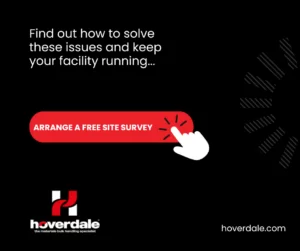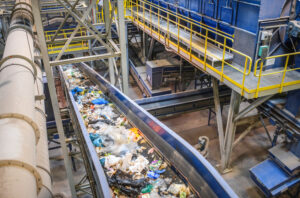In every Material Recycling Facility (MRF), conveyor belts are indispensable; they keep materials moving in and out by transporting bulk waste across plants, making processing and recycling easier and more efficient. However, like any machinery, conveyor belt systems can experience issues that cost your facility money, time, and resources. To help Plant Managers, we have compiled a list of five common issues that conveyor belts can experience and how you can solve your conveyor problems.
Belt Mistracking – Causing premature belt wear and damage
When your conveyor belt doesn’t track properly, it can result in uneven belt wear and tear, causing blockages and material spillages. An unaligned belt may be caused by a worn pulley, a misaligned conveyor frame, or an improperly installed belt. The best solution is to inspect your conveyor systems and identify any deviations regularly. You can use training tools like belt alignment tools and laser alignment systems to promptly detect and correct any belt-tracking issues.
2. Packed Belly Pans
When belly pans become packed full of material from a conveyor belt return, it can lead to several problems in industrial settings. One common issue is an increase in downtime and reduced efficiency. The material buildup can cause the conveyor belt to jam or stop altogether, resulting in production delays and lost productivity. The excess material can also damage the belt itself, leading to costly repairs or even the need for replacement. Another concern is the potential for spillage and contamination of surrounding areas, as the packed material may overflow from the belly pans. This can create safety hazards and require additional cleanup efforts. Regularly maintaining and cleaning belly pans are necessary to mitigate these problems to ensure smooth operation and prevent material buildup.
3. Stoppages Caused by Slipped, Worn and Dirty Belts
Belt slippage is when the conveyor belt slips on the drive pulley during operation. It can occur due to insufficient belt tension, worn pulleys, or material overload. Belt slippage can cause stoppages, reduce conveyor belt lifespan, lower processing capacity, and cause costly maintenance repairs. The solution to belt slippage is ensuring proper belt tension, repairing or replacing worn pulleys, and avoiding material overloading. Proper maintenance, belt cleaning and regular belt inspections can help you detect and address belt slippage before it escalates.
Belt damage can range from minor tears to severe mutilation and is caused by wear and tear operations. Conveyor belts used in recycling plants are susceptible to damage due to frequent exposure to sharp or abrasive materials. Belt damage can lead to catastrophic breakdowns, belting stoppages, and reduced conveyor efficiency. Plant managers should ensure regular belt inspections and maintenance and replace damaged belts immediately to prevent belt damage.
4. Belt Carryback and Material Build-up
Carryback is the material that attaches to the rollers, frames, and other conveyor system components, resulting in reduced efficiency. This carryback often consists of dust, debris, and other materials that stick to the conveyor belt and are only removed after falling off further downstream in the processing line. To properly combat carryback, it’s essential to understand the causes and how to prevent it. Investing in quality belt cleaners and other conveyor maintenance products can help avoid carryback.
Belt scrapers are an efficient way to manage stubborn material build-up on the conveyor system. Implementing various scraper types, from standard to motorised brushes, can provide an excellent solution to address the buildup of material. There are primary scrapers that clean as much material from the conveyor belt as possible. Secondary scrapers can be installed after the primary scrapers to ensure the belt is as clean as possible. The use of these scrapers helps ensure that the conveyor belt stays clean.
5. Material Blockages & Spillages
Material spillages occur when waste or recycled materials fall off the belt while in transit. Material blockages, worn conveyor parts, or inappropriate material loading can cause it. Material spillages can lead to workplace accidents, equipment wear and tear, and extra cleaning costs. To avoid spillages, you can install skirting rubber on the side of the belt to create a seal that will reduce any leakages; however, selecting the appropriate material for skirtings is crucial to avoid premature belt wear. It is not uncommon to come across instances where the wrong type of skirting is installed, but replacing it can prove to be cost-effective as it extends the overall lifespan of the belt. Additionally, you can use dust suppression systems to prevent material blockages and improve air quality in the recycling facility.
Conveyor belts are an essential part of any recycling plant, but they can experience issues that can result in downtime, belt stoppages, blockages, spillages, and the need for expensive, manual labour to correct them. With proper maintenance, routine inspections, and the right tools, plant managers can troubleshoot issues like belt mistracking, material spillages, belt slippage, belt damage, and belt misalignments. By addressing these issues promptly and proactively, recycling plants can improve operational efficiency, increase productivity, and save money in the long run.
Contact us today to see how we can solve conveyor problems.
Learn more about our range of conveyor belts, conveyor belt cleaners and scrapers and our motorised brush cleaning system for conveyors.






